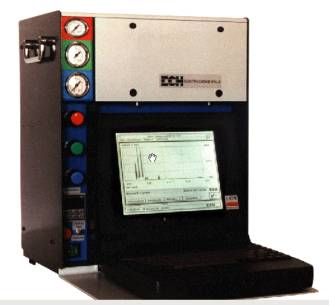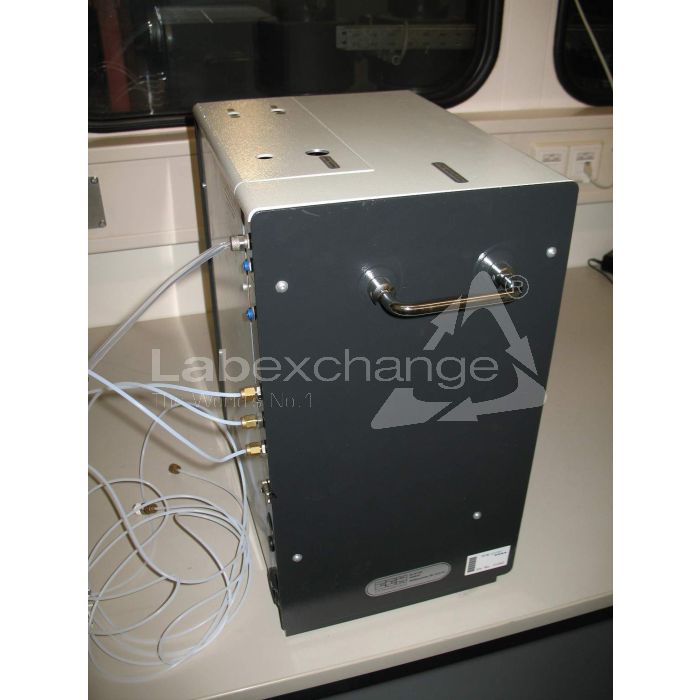ECH Mobil GC
| Objektnummer | B00014667 |
|---|---|
| Seriennummer | 014667 |
| Object Naam | ECH Mobil GC |
| Status | Stock unit |
Product groep: Gaschromatograaf (FID)
Status, leverings- en betalingsvoorwaarden
Apparatuurcontrole
De gebruikte apparatuur wordt voorafgaand aan levering gecontroleerd door Labexchange Service GmbH. U ontvangt volledig functionerende apparatuur.
Verzending
De vermelde verzendtijden zijn telkens de kortste voor een artikel. In bepaalde gevallen kunnen de daadwerkelijke verzendtijden daarvan afwijken. De uiteindelijke verzendtijden worden aangegeven in de opdrachtbevestiging.
In de regel bieden we combinatieleveringen aan. Levertijden zijn afhankelijk van het artikel met de langste levertijd. Deelleveringen zijn mogelijk tegen een toeslag.
Verzendmethoden
Koeriersdiensten, transportbedrijven, zelf afhalen, levering door Labexchange wagenpark
Informatie levering
De prijzen zijn exclusief verzendkosten. De genoemde verzendkosten zijn de te verwachten kosten. Afwijkingen zijn mogelijk. In het geval geen kosten voor verzending zijn gespecificeerd, vraag die dan afzonderlijk aan.
De opgegeven vracht- en verpakkingskosten hebben betrekking op de goedkoopste transportroute en zijn onder voorbehoud van onvoorziene kostenstijgingen. Door onvoorziene gebeurtenissen kunnen vrachttarieven en levertijden op elk moment veranderen en moeten ze worden aangepast aan de huidige situatie. Incoterm coderingen volgens Incoterms 2010: Bij afhalen EXW, CFR voor zendingen over zee, CPT per luchtfracht, andere zendingen DAP. Opmerking: We geven geen preferentieel certificaat/EUR1 af. Bij zelf afhalen/af fabriek (EXW) uit derde landen en de EU wordt 16% btw als borg ingehouden, tot we de ontvangstbevestiging/het leveringscertificaat van de koper hebben ontvangen.
Betalingsvoorwaarden
Wij accepteren geen betalingen Letter of Credit, PayPal etc. Het factuurbedrag is volledig verschuldigd. Er zijn geen betalingskortingen. De goederen blijven tot volledige betaling ons eigendom.
|
Land |
Mogelijke betaalmethoden |
Opmerking |
|
Duitsland, Oostenrijk, Zwitserland |
Betaling via factuur, vooruitbetaling, per creditkaart |
Betaling via factuur is mogelijk voor ondernemingsklanten. |
|
Nederland, België en Luxemburg |
Betaling via factuur, vooruitbetaling, per creditkaart |
Betaling via factuur is mogelijk voor ondernemingsklanten. |
|
Andere landen |
vooruitbetaling, per creditkaart |
|
Onze Algemene Voorwaarden voor Verkoop, Levering en Betaling zijn hierop van toepassing. Deze voorwaarden zijn hier te downloaden.
Tussenverkoop is ons voorbehouden.
Beschrijving status:
Alle artikelen zijn gebruikte artikelen, tenzij bij een artikel uitdrukkelijk wordt vermeld dat het om een nieuw apparaat gaat.
Firma: ECH
Nachfolgende Abbildungen und Beschreibungen sind modellbezogen und aus Prospekten entnommen.
Sie geben nicht den Lieferumfang des Systems wieder.
Den exakten Lieferumfang entnehmen Sie bitte aus dem Angebotstext.

Der MobilGC ist ein automatisiertes Gerät, welches durch innovative Technik neue Einsatzmöglichkeiten für unterschiedliche analytische Problemstellungen erschließt. Wesentliches Element des Gaschromatographen ist ein neuartiger Säulenofen, der ein kleines, aber leistungsstarkes Heizelement enthält. Direkt an diesem wird die Trennsäule montiert. Das gesamte System ist isoliert und durch einen Metallkäfig geschützt. Als Paket kann die Trennkassette mit wenigen Handgriffen ein- und ausgebaut werden und gestattet somit eine äußerst flexible Säulenauswahl. Im GC ist Platz für zwei Trennsäulenkassetten vorgesehen, die mit unterschiedlicher Temperatur betrieben werden können.
Der GC kann mit bis zu zwei Injektoren, drei Mikroventilen und zwei verschiedenen Detektoren ausgestattet werden und ist durch zusätzliche Module erweiterbar. Außer mit dem Injektor kann die Probe auch über ein automatisches Probenventil in Verbindung mit einer Probenschleife und einer Membranpumpe aufgegeben werden. Für Spurenanalytik ist ein Anreicherungsmodul erhältlich.
Ein zu jedem Detektor gehörender Analog/Digital-Wandler erzeugt digitalisierte Mess-Signale, welche im jeweils nachgeschalteten Rechner aufbereitet werden. Die Steuerung erfolgt über einen im MobilGC enthaltenen Mikrocontroller vom PC aus. Die Verwendung digitalisierter Signale gestattet einen einfachen Aufbau und Miniaturisierung. Es wird ein deutlich verbessertes Signal/Rausch-Verhältnis erzielt und damit verbunden eine erhöhte Nachweisempfindlichkeit.
Die Kommunikation der Steuerelektronik des MobilGC mit dem Rechner erfolgt über die serielle Schnittstelle. Ein auf dem Rechner laufendes Steuer- und Auswerteprogramm ermöglicht die Aufzeichnung aller messungsrelevanten Daten, Chromatogramme sowie der Messergebnisse.
Technische Parameter
Abmessungen: Breite: 380 mm
Höhe-. 450 mm
Tiefe: 235 mm
Masse: ca. 20 kg
Betriebstemperatur: 5..40 °C
Lagertemperatur: 0..75 °C
Relative Feuchte: 0..80 %
Netzspannung: 230V/50Hz
Im Grundgerät sind folgende Baugruppen angeordnet und verschaltet:
Pneumatikmodul
Detektorofen (mit Detektoren und Injektor)
Säulenofen (mit Trennsäulen)
Netzteil mit Stromversorgung
Steuerelektronik
Pneumatikmodul
Im Grundgerät ist ein Pneumatikmodul, bestehend aus einem Druckregler und dem dazugehörigen Manometer, enthalten. Alle Verrohrungen im MobilGC bestehen aus 1,6 mm Edelstahlrohr mit Aluminium- bzw. GRAPH-FITT-Verschraubungen. Der Druckregler ist als gaschromatographischer Feindruckregler ausgeführt und durch entsprechende Beschriftungen gekennzeichnet.
Trägergas: Helium, Wasserstoff, Stickstoff oder Argon
Brenngas-. Wasserstoff
synthetische Luft
Der eingestellte Vordruck liegt in der Größenordnung von ca. 1,0 bar. Die Mindestdruckdifferenz zwischen Eingang und Ausgang der gesamten Pneumatik zwecks störungsfreier und ordnungsgemäßer Arbeit beträgt ca. 1 bar.
Detektorofen
Im beheizbaren, thermisch isolierten Detektorofen sind die Detektoren, der Injektor, das Schaltventil und alle beheizten Transferleitungen montiert.
Es sind zwei unabhängige Flammenionisationsdetektoren (FID) eingebaut. Der FID spricht auf fast alle organischen Komponenten an. Durch seine Empfindlichkeit, Stabilität und einfache Wartung ist er der am häufigsten eingesetzte Detektor.
Netzteil
Das Netzteil stellt nach einer Transformierung der angeschlossenen Netzspannung (220..230 V/50 Hz) die für den Betrieb des Gerätes notwendigen Schutzkleinspannungen zur Verfügung.
Steuerelektronik
Innerhalb des MobilGC ist eine von der ECH entwickelte Mikrocontrollerkarte als selbständige Messkarte eingebaut. Sie übernimmt die Signalauswertung der Detektoren sowie die interne Umsetzung der Gerätesteuerkommandos vom Steuerrechner (PC). Die Kommunikation zwischen Steuerelektronik und Steuerrechner erfolgt über die serielle Schnittstelle RS 232 mittels eines entsprechenden Verbindungskabels.
Steuerrechner
Als Steuerrechner kommt ein Notebook oder PC vom Typ Pentium/586-DX66 mit 16 MB Hauptspeicher oder besser zum Einsatz. Auf ihm ist die Steuersoftware gespeichert. Nur durch diese Kombination ist der MobilGC als tragbares Gerät vor Ort einsetzbar.
Injektionssysteme
Injektor
Der GC kann mit zwei Injektoren, senkrecht im Heizblock auf der Geräterückseite montiert, versehen werden. Hier können Gase oder Flüssigkeiten mittels einer gasdichten Spritze (üblicherweise Mikroliterspritzen mit Dosiervolumen von 0-200 µ) mittels Durchstechen des Septums (gasdichter Verschluss am oberen Abschluss des jeweiligen Injektors) gespritzt werden. Es wird empfohlen, das Septum nach ca. 20 Injektionen zu wechseln. Wird eine abgerundete Nadel mit seitlichem Eingang verwendet, ist der Verschleiß geringer.
Achtung! Die Injektionsgenauigkeit (möglichst identische Vorgehensweise) hat großen Einfluss auf die Reproduzierbarkeit der Ergebnisse.
Dosierventil mit Probenschleife
Der MobilGC ist mit einem 6-Port-Dosierventil ausgerüstet, welches elektrisch betrieben wird und mit einer Probenschleife kombiniert ist. Die Schleife besteht aus einem spiralförmigen Rohr, dessen Volumen genau definiert ist (200 µl). Das Ventil ist im Ventilofen eingebaut.
Die Temperatur der Probenschleife ist mit der des Detektor-Ofens identisch. Kalibrierung und Betrieb müssen bei gleichen Temperaturen erfolgen. Der gesamte Dosiervorgang wird über den Rechner gesteuert. Er läuft bei jedem Start einer Messung automatisch ab.
Beachte:
ausreichende Spülzeit der Dosierschleife beachten (insbesondere beim Ansaugen der Probe aus langen Gasleitungen
als Standard ist eine 200-pl-Probeschleife installiert
das Volumen der Dosierschleife bestimmt die Trennleistung
Die maximale Betriebstemperatur des Gasprobenventils richtet sich nach dem verwendeten Dichtmaterial; es sind bei allen zum Einsatz kommenden Materialien Temperaturen nicht höher als 180 °C relevant. Die Mikroventile sind bis 10 bar druckstabil.
Achtung! Die Injektionsgenauigkeit (möglichst identische Vorgehensweise) hat großen Einfluss auf die Reproduzierbarkeit der Ergebnisse.
Säulenofen und Trennsäulen
Säulenofen
Der Säulenofen ist als kompakte Kassette aufgebaut, bestehend aus einem kleinen, aber leistungsstarken Heizelement, der Trennsäule, einem Lüfter, Isolierung aus Keramikwatte und einem Metallgehäuse als Schutz. Als Paket kann die Trennkassette mit wenigen Handgriffen ein- und ausgebaut werden und gestattet somit eine äußerst flexible Säulenauswahl.
Im MobilGC sind zwei Trennsäulenkassetten montiert, die mit unterschiedlicher Temperatur betrieben werden können. Beide Kassetten sind mit einem Lüfter ausgerüstet und können daher sowohl isotherm als auch mit einem Temperaturprogramm beheizt werden, welches über das Steuerprogramm definiert wird.
Aus Sicherheitsgründen ist der Säulenofen geerdet. Die Temperaturregelung erfolgt über den im Gerät integrierten Mikrocontroller. Nach dem Abstellen der Heizung (und vor dem Schließen der Trägergasversorgung) sollten Trägergasstrom und Säulenlüfter die Temperatur der Trennsäule auf Raumwert herunterkühlen.
Bei Bruch kann die Säule in begrenztem Umfang nachgezogen werden. Sollten hierbei Unklarheiten oder Komplikationen auftreten, konsultieren Sie bitte Ihre zuständige Servicevertretung oder unser Applikationslabor.
Zum Ein- und Ausbau der Säulenkassette wird der MobilGC nach Abnahme der
Rückwand auf die Vorderseite gelegt, und die Halteschiene an der Unterseite des Ventilofens abgenommen. Anschließend ist, nach Lösen der Säulenverschraubungen und Abziehen der elektrischen Verbindung, eine Demontage des kompletten Säulenofens möglich-.
Austausch aller Innenteile des Säulenofens (mechanischer Teil, Säule, Heizelemente usw.) oder
Demontage des Ofens und Wechsel der Säule
Erstere Möglichkeit ist einfacher, nimmt allerdings mehr Zeit in Anspruch, da die Einheit an den Hersteller gesendet und nach der Reparatur entsprechend rückgesandt werden muss.
Zum Ausbau der Säule oder des Ofens müssen die beiden Endverbindungen der Säule mit dem System gelöst werden.
Für den Anschluss der Säulenkassette ist die entsprechend markierte DIN-Buchse vorgesehen.
Trennsäulen
Zum Zwecke einer qualitativen Analyse werden die Komponenten des injizierten Gasgemisches in der Säule aufgetrennt. Die Reihenfolge der Komponenten bleibt aufgrund ihrer spezifischen Retentionszeiten gleich. Beste Analysenergebnisse werden mit einer Kapillarsäule mit einem Innendurchmesser von 0.32 bis zu 0.53 mm und einer Länge von bis zu 30 m erzielt.
Vor der ersten Messung mit der Trennsäule ist diese bei eingeschaltetem Trägergasstrom und einer vom Säulentyp abhängigen Ofentemperatur (Säulentyp beachten) solange zu konditionieren, bis der Grundlinienwert konstant ist. Die Konditionierung muss bei maximaler Ofentemperatur und Trägergasstrom durchgeführt werden.
Wird die Kapillarsäule direkt an den FID angeschlossen, muss sie unbedingt zentrisch eingebaut werden. Auf der Detektorseite ist sie bis zur Düsenoberkante zu fädeln. Ragt die Säule in die FID-Flamme, zersetzt sich die Polyamidschicht und es tritt hohes Hintergrundrauschen auf. Ist sie zu weit entfernt, ergeben sich Probleme durch Totvolumina.
Im Säulenofen kann die Kapillarsäule isotherm oder mittels Temperaturgradienten (max. 40 Grad/min) auf 250 °C aufgeheizt werden. Die beste Reproduzierbarkeit wird erfahrungsgemäß erzielt, wenn mit einem leicht unter dem Maximum liegenden Gradienten gearbeitet wird (z. B. 30 Grad/min), da auf diese Weise lokale Spannungsschwankungen gut kompensiert werden.
Optimale Trennleistungen von Kapillarsäulen ergeben sich bei der Beachtung grundsätzlicher Bedingungen:
Kapillarsäulen stehen heute mit einer Vielzahl an Parameterkombinationen, wie Innendurchmesser, Länge, stationäre Phase und Filmdicke, zur Verfügung. Auswahlkriterium für die optimalen Säulenabmessungen ist das Phasenverhältnis ß (dimensionslose Zahl, die das Verhältnis des Kapillarsäuleninnendurchmessers zur Filmdicke angibt und dem Verhältnis zwischen dem Gas- und dem Phasenvolumen entspricht). Säulen mit gleichem ß-Wert haben bei gleichen Analysenbedingungen einschließlich gleicher stationärer Phase fast identische relative Retentionszeiten. Bei definierter Aufgabenstellung ist somit eine korrekte Säulenwahl möglich.
Probenkapazitätserhöhung wird durch Einsatz einer Säule mit größerem Innendurchmesser und dickerem Film erreicht.
Eine Erhöhung der Trennsäulenleistung erzielt man mit geringerem Innendurchmesser und verringerter Filmdicke, jeweils gleiche ß-Werte zu Grunde gelegt. Die Trenncharakteristik bleibt voll erhalten.
Das Arbeiten mit dem FID (Flammenionisationsdetektor)
Technische Parameter
Nachweisgrenze: ca. 5 x 10 -12 g Kohlenstoff
Linearität. > 106
techn. Angaben: Düse: Keramik
Aufbau: Gasdichtes Gehäuse
Totvolumen: praktisch Null mit Kapillarsäulen, vernachlässigbar bei gepackten Säulen
Make-up-Gas-. möglich
Polarisationsspannung: -170 V
Bereich: 10 -9 ..10 -12 A/MV
Empfindlichkeit: 15 mC/g für Kohlenwasserstoffe
Rauschen: 10 bis 25 Counts
Arbeitsweise
An der Flammendüse des Detektors wird eine Spannung angelegt. Das aus der Säule austretende Trägergas wird an der Düsenspitze von einer Wasserstoffflamme erwärmt. Dabei werden Ionen erzeugt, die auf dem Weg zum Kollektor einen geringen Strom (Signal) abgeben. Gelangt mit dem Trägergas eine organische Substanz in die Flamme, steigt durch deren lonisierung der Strom (Signal) an. Dies wird als Peak im Chromatogramm sichtbar.
Beschreibung des FID
Mit einem Flussmesser können unmittelbar an den Eingängen die Strömungsgeschwindigkeiten der verschiedenen Gase bestimmt werden.
Die Durchflussverhältnisse von Luft zu Wasserstoff sollen in etwa 10:1 betragen (ca. 200..300: 20..30 ml/min). Mittels einer Glühkerze wird die Flamme gezündet. Der Detektor muss vor der Zündung ca. 20 min aufgeheizt und beim Betrieb eine Arbeitstemperatur über 100 °C haben. Der Wasserstoffstrom sollte für die Zündung über dem empfohlenen Durchfluss bei Betrieb liegen. Am plötzlich ansteigenden Indikatorwert und dumpfen Knall ist eine erfolgreiche Zündung zu erkennen. Ein weiteres sichtbares Zeichen ist das Beschlagen eines über dem Detektorausgang angebrachten Spiegels.
Nach der Zündung tritt häufig eine erhebliche Schwankung des Indikatorwertes auf, so dass eine gewisse Stabilisierungsphase abgewartet werden muss.
Anschließsend kann die Wasserstoffzufuhr auf Normalwert reduziert werden, bis eine Grundlinie von einigen Tausend µV erreicht ist.
FID-Temperatur, Make-Up-Gas, H 2 -Strom und verschiedene andere Einflüsse könne die Grundlinie veränderen, was ein Nachregeln auf die gewünschte Werte erfordert.







